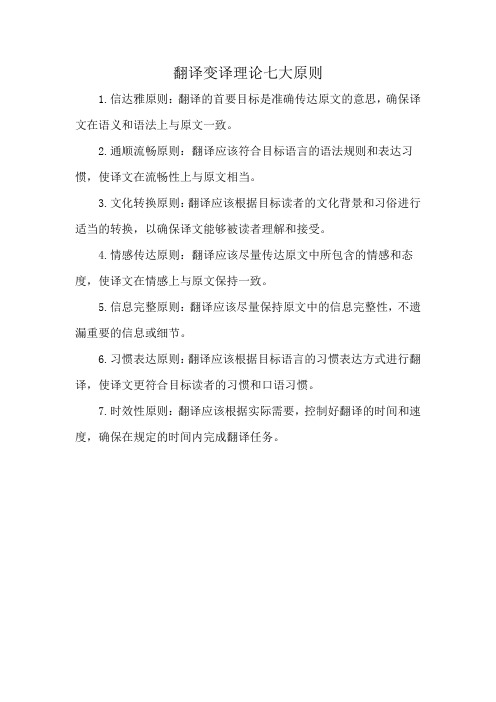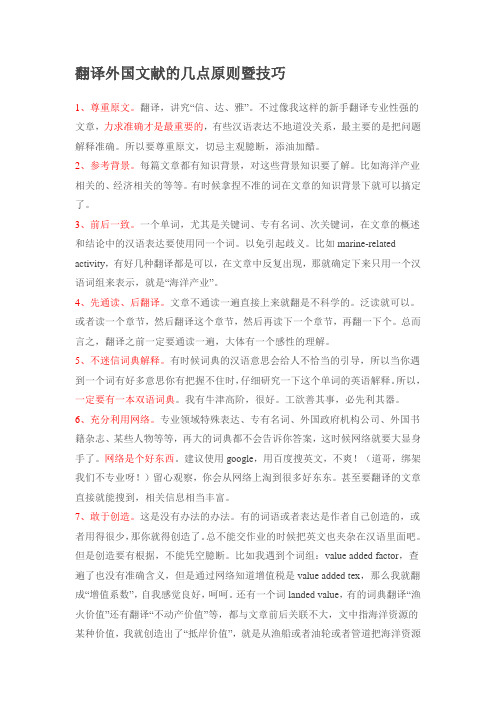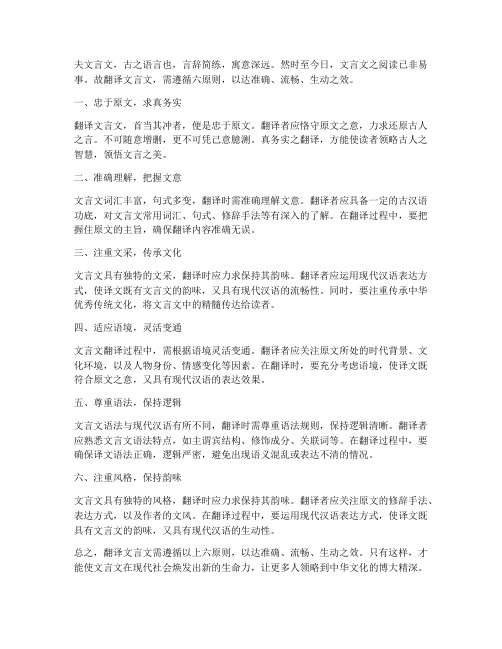翻译原则
英语翻译原则

英语翻译原则英语翻译是一门艺术和科学的结合。
对于一个好的翻译者来说,掌握一定的翻译原则是非常重要的。
下面是几个英语翻译的原则:1. 准确性准确性是翻译的基本原则。
翻译过程中要保证译文和原文的准确性,不能随意加减或修改原文的内容。
译文应与原文保持一致,并传达出原文的意思。
2. 通顺性译文应该通顺、连贯,符合英语的语法规则和表达习惯。
句子结构、语序、词语搭配等都要符合英语的表达方式,使译文更容易被理解和接受。
3. 忠实性忠实性是指译文要忠实于原文的意思和风格,不凭主观意愿对原文进行偏颇的解释或添加自己的观点。
翻译应尽量保留原文的语言特点和表达方式,使读者感受到原文的原汁原味。
4. 简洁性译文要力求简洁明了,避免冗长和重复,使读者能够更清晰地理解译文的意思。
5. 专业性翻译是一门专业技巧和知识的结合。
翻译者应具备扎实的语言功底和广博的知识背景,特别是对于特定领域的专业术语和行业常识要有所掌握。
尤其对于科技、医学、法律等领域的翻译,对相关专业知识的理解和正确运用至关重要。
6. 文化转化英语翻译要考虑到不同的文化背景和传统。
有些语言和表达方式在不同的文化环境中可能会有不同的理解和意义。
翻译时应根据目标读者的文化背景和阅读习惯进行文化转化,使译文更容易为他们理解和接受。
7. 上下文理解在翻译过程中要注重上下文的理解,尤其是对于一些歧义或难以理解的句子。
只有对原文的前后文有深入的理解,才能准确传达出原文的意思。
总之,英语翻译要保证准确、通顺、忠实于原文,并考虑到专业性、简洁性、文化转化和上下文的理解。
翻译者要具备扎实的语言和专业知识,具有良好的语言表达和理解能力,才能做出高质量的翻译作品。
文言文翻译原则及方法

3.补谓语:一鼓作气,再而衰,三而竭。
第一次击鼓能够振作士兵们的士气,第二次 ( 击鼓 ) 士兵们的 士气就开始低落了,第三次(击鼓)士兵们的士气就耗尽了。
4.补介词:晋军函陵,秦军氾南。
晋军驻扎(在)函 陵 , 秦 军 驻 扎 ( 在 ) 氾 南 。
5.补量词:口技人坐屏障中,一桌、一椅、一扇、一抚尺而 已。
文言文翻译原则
一 信、达、雅 二 字字落实,直译为主,意译为辅。
文言文翻译原则一:信、达、雅
1.“信”:真实,准确。实词虚词做到字字落实,不可以随 意增减内容。
例:六国破灭,非兵不利,战不善,弊在赂秦。
译文:六国被攻破灭亡,不是武器不锋利,战术不恰当,弊病 在于贿赂秦国。
2、“达”:通顺,流畅。合乎现代汉语语法规范及语言表达
练习:
人名、年号
地名
1.赵惠文王十六年,廉颇为赵将伐齐,大破之,取阳晋,拜为 上卿,以勇气闻于诸侯。
官名
与现代汉语义同
译文: 赵惠文王十六年,廉颇作为赵国的将领征讨齐国,大败 齐军,夺取了阳晋,被封为上卿,他凭借勇气在各国诸侯间闻 名。
二 补:补充。 需要补充的有以下两种情况:第一种情况是,古代汉语大多是 单音词,现代汉语的双音词中有不少是以文言词汇为基本词素 而发展成的。翻译时,要把这些文言单音节词补充为相应的现 代汉语双音词。 学不可以已。 译:学习不可以停止。 吾尝终日而思矣。 译:我曾经一天到晚地思考。 第二种情况,补出文言文中省略的成分或隐含的成分,如句子 中省略的主语、谓语、宾语以及介词“于”等,从而使句意完 整。
①文言词汇
现代汉语词汇
②词类活用词
活用后的词;
③通假字
本字;
④古义
今义、引申义、比喻义。
翻译变译理论七大原则

翻译变译理论七大原则
1.信达雅原则:翻译的首要目标是准确传达原文的意思,确保译文在语义和语法上与原文一致。
2.通顺流畅原则:翻译应该符合目标语言的语法规则和表达习惯,使译文在流畅性上与原文相当。
3.文化转换原则:翻译应该根据目标读者的文化背景和习俗进行适当的转换,以确保译文能够被读者理解和接受。
4.情感传达原则:翻译应该尽量传达原文中所包含的情感和态度,使译文在情感上与原文保持一致。
5.信息完整原则:翻译应该尽量保持原文中的信息完整性,不遗漏重要的信息或细节。
6.习惯表达原则:翻译应该根据目标语言的习惯表达方式进行翻译,使译文更符合目标读者的习惯和口语习惯。
7.时效性原则:翻译应该根据实际需要,控制好翻译的时间和速度,确保在规定的时间内完成翻译任务。
翻译的几点原则

翻译外国文献的几点原则暨技巧1、尊重原文。
翻译,讲究“信、达、雅”。
不过像我这样的新手翻译专业性强的文章,力求准确才是最重要的,有些汉语表达不地道没关系,最主要的是把问题解释准确。
所以要尊重原文,切忌主观臆断,添油加醋。
2、参考背景。
每篇文章都有知识背景,对这些背景知识要了解。
比如海洋产业相关的、经济相关的等等。
有时候拿捏不准的词在文章的知识背景下就可以搞定了。
3、前后一致。
一个单词,尤其是关键词、专有名词、次关键词,在文章的概述和结论中的汉语表达要使用同一个词。
以免引起歧义。
比如marine-related activity,有好几种翻译都是可以,在文章中反复出现,那就确定下来只用一个汉语词组来表示,就是“海洋产业”。
4、先通读、后翻译。
文章不通读一遍直接上来就翻是不科学的。
泛读就可以。
或者读一个章节,然后翻译这个章节,然后再读下一个章节,再翻一下个。
总而言之,翻译之前一定要通读一遍,大体有一个感性的理解。
5、不迷信词典解释。
有时候词典的汉语意思会给人不恰当的引导,所以当你遇到一个词有好多意思你有把握不住时,仔细研究一下这个单词的英语解释。
所以,一定要有一本双语词典。
我有牛津高阶,很好。
工欲善其事,必先利其器。
6、充分利用网络。
专业领域特殊表达、专有名词、外国政府机构公司、外国书籍杂志、某些人物等等,再大的词典都不会告诉你答案,这时候网络就要大显身手了。
网络是个好东西。
建议使用google,用百度搜英文,不爽!(道哥,绑架我们不专业呀!)留心观察,你会从网络上淘到很多好东东。
甚至要翻译的文章直接就能搜到,相关信息相当丰富。
7、敢于创造。
这是没有办法的办法。
有的词语或者表达是作者自己创造的,或者用得很少,那你就得创造了。
总不能交作业的时候把英文也夹杂在汉语里面吧。
但是创造要有根据,不能凭空臆断。
比如我遇到个词组:value added factor,查遍了也没有准确含义,但是通过网络知道增值税是value added tex,那么我就翻成“增值系数”,自我感觉良好,呵呵。
文言文翻译的六原则

夫文言文,古之语言也,言辞简练,寓意深远。
然时至今日,文言文之阅读已非易事。
故翻译文言文,需遵循六原则,以达准确、流畅、生动之效。
一、忠于原文,求真务实翻译文言文,首当其冲者,便是忠于原文。
翻译者应恪守原文之意,力求还原古人之言。
不可随意增删,更不可凭己意臆测。
真务实之翻译,方能使读者领略古人之智慧,领悟文言之美。
二、准确理解,把握文意文言文词汇丰富,句式多变,翻译时需准确理解文意。
翻译者应具备一定的古汉语功底,对文言文常用词汇、句式、修辞手法等有深入的了解。
在翻译过程中,要把握住原文的主旨,确保翻译内容准确无误。
三、注重文采,传承文化文言文具有独特的文采,翻译时应力求保持其韵味。
翻译者应运用现代汉语表达方式,使译文既有文言文的韵味,又具有现代汉语的流畅性。
同时,要注重传承中华优秀传统文化,将文言文中的精髓传达给读者。
四、适应语境,灵活变通文言文翻译过程中,需根据语境灵活变通。
翻译者应关注原文所处的时代背景、文化环境,以及人物身份、情感变化等因素。
在翻译时,要充分考虑语境,使译文既符合原文之意,又具有现代汉语的表达效果。
五、尊重语法,保持逻辑文言文语法与现代汉语有所不同,翻译时需尊重语法规则,保持逻辑清晰。
翻译者应熟悉文言文语法特点,如主谓宾结构、修饰成分、关联词等。
在翻译过程中,要确保译文语法正确,逻辑严密,避免出现语义混乱或表达不清的情况。
六、注重风格,保持韵味文言文具有独特的风格,翻译时应力求保持其韵味。
翻译者应关注原文的修辞手法、表达方式,以及作者的文风。
在翻译过程中,要运用现代汉语表达方式,使译文既具有文言文的韵味,又具有现代汉语的生动性。
总之,翻译文言文需遵循以上六原则,以达准确、流畅、生动之效。
只有这样,才能使文言文在现代社会焕发出新的生命力,让更多人领略到中华文化的博大精深。
翻译者应不断学习,提高自己的古汉语水平,努力为传承中华优秀传统文化贡献力量。
翻译三原则

翻译三原则
翻译的三个原则是直译原则、意译原则和文化转换原则。
直译原则是指尽可能保持原文词句的顺序和结构,尽量避免对原文进行任何改动。
这个原则适用于那些词语和句子在另一种语言中有相对应的词汇和语法结构的情况。
直译原则主要考虑的是语言的准确性和忠实性,它能够保持原文的原汁原味,让读者能够更好地理解原作者的意图。
意译原则是指在翻译过程中,允许对原文进行一定程度的修改和改编,以使译文更符合目标语言的表达习惯和语法规则,并让读者更好地理解原文的内容。
在意译的过程中,译者可以采用增减词语、转换句子结构、调整语气和修饰等手段来进行翻译。
意译原则主要考虑的是读者的理解和感知,以及译文的流畅度和自然度。
文化转换原则是指在翻译过程中考虑到不同语言和文化之间的差异,将原文中的文化元素和背景信息转换为目标语言所对应的文化元素和背景信息。
文化转换原则要求译者具备一定的跨文化交流能力,能够理解和分析不同语言和文化之间的差异,以确保译文能够在目标文化中得到正确的理解和接受。
这三个原则在翻译过程中相互关联和相互作用,译者需要根据具体的翻译任务和目标读者的需求来选择和应用不同的原则。
在实际操作中,译者通常会根据翻译的难易程度、原文的特点、目标读者的背景和目的等因素来确定所采用的翻译原则。
翻译的定义和基本原则

翻译的定义和基本原则翻译是人类社会交流的重要方式之一。
通过翻译,不同语言、不同文化的人们可以相互理解、相互沟通,促进交流和合作。
翻译的定义很简单:翻译就是把一种语言的意思,用另一种语言表达出来,以达到跨越语言和文化的交流目的。
但是,翻译的过程和方法并不简单,需要遵循一定的基本原则。
一、精准性原则翻译的首要目标是保持原意的精准性。
翻译过程中,应尽力理解原意,掌握原意所在的文化背景、历史背景和社会背景。
翻译时,必须把原意准确、完整、清晰地表达出来,不能脱离原文的含义、语境、语气和情感,不能添加、删除、曲解原意。
只有保持原意的精准性,才能达到翻译的真正意义。
二、通顺性原则翻译的第二个原则是保持语言的通顺性。
通顺性是指翻译后的文章在语法、语调、语气等方面与目标语言相符合,并且能够流畅地表达意思,使读者易于理解。
在翻译时,应当注意词语的用法和特殊标点符号的使用,以确保文章的通顺性。
一个理解完全正确的翻译,如果语言结构不通顺,往往会使目标语言读者感到阅读起来困难,甚至会引起误解。
三、忠实原则翻译的第三个原则是忠实原则。
忠实原则是指在翻译过程中,应该尽可能忠实地表达原文中的含义和文化背景。
在翻译时,应该尽可能保留原文中的文化元素和情感,注意原文的所在文化环境和历史背景。
翻译应该尽量把原意传达到目标语言读者,让目标语言读者能够体验到原文的精神内涵和文化特色。
四、通用性原则翻译的第四个原则是通用性原则。
通用性原则是指翻译应该根据目标语言读者的文化背景和语言环境,考虑使用熟悉、通用的语言和表达方式。
翻译不是简单的把原文转化成目标语言,而是在保持原文意思的基础上,适当调整语言表达的方式,以符合目标语言读者的习惯和口味。
五、美感原则翻译的第五个原则是美感原则。
美感原则是指在翻译过程中,应该尽量保持原文的文学艺术风格和特色,同时在目标语言的语言和文化环境中发挥其艺术价值。
翻译应该不仅仅是简单的文字转化,而是在语言的表达上发挥自己的创造力,让目标语言读者能够体验原文的文学之美。
英语口译翻译的十大原则

英语口译翻译的十大原则英语口译是一项需要高度专业性和灵活性的工作,成功的口译翻译不仅需要精通两种语言,还需要具备良好的解读和传达能力。
以下是英语口译翻译的十大原则。
1.准确性准确性是口译翻译最重要的原则之一、口译翻译需要准确无误地传达源语言的意思,确保译文准确无误地传达到目标语言的听众。
2.流畅性流畅性是口译翻译的另一个重要原则。
译员需要以自然流畅的方式传达信息,使听众能够顺利地理解译文。
3.忠实传达口译翻译需要忠实地传达源语言的意思,而不是进行主观解释或添加个人观点。
译员应尽力保持中立,并尽可能忠实地转达源语言中的含义。
4.适应目标文化口译翻译需要考虑目标文化的特点和习惯。
译员需要了解目标文化的背景和语言表达习惯,以便更好地传达信息。
5.回避歧义口译翻译需要尽量避免歧义和模糊表达。
译员应通过合适的语言表达和衔接手段来清晰地传达信息,以确保听众正确理解。
6.简洁明了口译翻译需要保持简洁明了,避免过多的修饰和累赘的句子结构。
译员应尽量使用简短明了的语言,以保持听众的专注和理解。
7.时效性口译翻译需要在接收到信息后迅速准确地进行转达。
译员需要具备快速反应和思维敏捷的能力,以便及时地传达信息。
8.语法准确口译翻译需要遵循源语言和目标语言的语法规则。
译员应注意语法结构的正确性,并尽量避免语法错误和不通顺的表达。
9.场景感知口译翻译需要根据不同的场景和语境来进行适当的翻译。
译员应根据具体的场合和需求,选择合适的词汇和表达方式来传达信息。
10.职业道德口译翻译需要遵守职业道德准则,保持译员的中立性和保密性。
译员应尽力避免个人偏见和利益冲突,确保译文的专业性和可信度。
以上是英语口译翻译的十大原则。
通过遵循这些原则,口译翻译能够更好地传达信息并实现沟通的目的。
- 1、下载文档前请自行甄别文档内容的完整性,平台不提供额外的编辑、内容补充、找答案等附加服务。
- 2、"仅部分预览"的文档,不可在线预览部分如存在完整性等问题,可反馈申请退款(可完整预览的文档不适用该条件!)。
- 3、如文档侵犯您的权益,请联系客服反馈,我们会尽快为您处理(人工客服工作时间:9:00-18:30)。
Translation MethodsTeaching PlanTeaching Contents:1. Translation principles2. Definition of translation methods2. Explanation of word-for-word translation, literal translation, free translation3. Exercises for different translation methodTeaching PlanTeaching Aims:1. To make students get the knowledge of different translation methods2. To know when and how to apply different translation methods in different situations through doing exercises.Teaching Focus:Translation methods and their differencesTeaching Methods:Discussion (group work, then class work) and teacher-oriented lecturingTeaching Procedures:Step 1Questions for discussion1. What translation principles have you ever heard of? What are they?2. What translation methods have you ever known? What are they?3. What is word-for-word translation?4. What is literal translation? What is the difference between word-for-word translation and literal translation?Step 2Translation principlesI. Definition of PrinciplePrinciples / criteria refers to established standards or principles on which an action or judgment is based.the principle of translation:the one as a goal set for translators to strive after the criterion of translation:the one as a standard / yardstick for measuring the professional level of translationII. Some influential principles1. Yan Fu’s Three-character Principle (Requirement / Criteria) (1898):The so-call principles and criteria of translation are actually the two sides of the same thing. The former lays emphasis on the translator, who should follow them while translating; while the latter on the reader or critic, who may use the criteria to evaluate translation works. Whenever principles or criteria of translation are under discussion in China, Yan Fu’s “three-character guide”, which was first proposed in 1898, would evoke controversy, namely the principle of “faithfulness, expressiveness and elegance”.2. Fu Lei’s “Similarity in Spirit” (1957) & Qian Zhongshu’s “Sublimation” (1963)As far as the effect is concerned, translation should be like coping a painting. What is desired is not being alike in appearance but being alike in spirit. The transmigration of souls, “Although the body changes, the soul of gesture remains its old self.”严复“信、达、雅”林语堂“忠、顺、美”梁实秋、赵景琛“宁错务顺”鲁迅“宁信不顺”瞿秋白“信顺统一”傅雷“形似神似”钱钟书“入化境界”Step 3Translation MethodsI. Word for Word Translation•C-E•人山人海--people mountain people sea--huge crowd of people/ a sea of faces•红颜知己--red face know me•好久不见--Long time no see.--I haven’t see you for ages.•马马虎虎--Horse, horse; tiger, tiger--Just so so. Not too bad.II. Literal TranslationSuperficially speaking, literal translation means “not to alter the original words and sentences”; strictly speaking, it strives “to keep the sentiments and style of the original” It takes sentences as its basic units and takes the whole text into consideration at the same time in the course of translation. Furthermore, it strives to reproduce both the ideological content and the style of the original works and retains as much as possible the figures of speech. There are quite a lot of examples of successful literal translation that have been adopted as idiomatic Chinese expressions. Examples:crocodile’s tears 鳄鱼的眼泪armed to the teeth 武装到牙齿chain reaction 连锁反应gentlemen’s agreement君子协定纸老虎paper tiger一国两制one country, two systemsExercises:1. to keep the room clean and tidy---保持房间清洁2. to enrich cultural life---丰富文化生活3. under such circumstances---在这种情况下4. to fish in troubled water---浑水摸鱼5. to add fuel to the fire---火上加油6. 打破纪录--- to break the record7. 君子协定--- a gentleman’s agreement8. 血浓于水--- Blood is thicker than water.9. 人们笑贫不笑娼--- People ridicule poverty but not prostitutes.III. Free TranslationFree translation is an alternative approach that is used mainly to convey the meaning and spirit of the original without trying to reproduce its sentence patterns or figures of speech. This approach is most frequently adopted when it is really impossible for the translator to do literal translation.Examples:1) Adam’s apple喉结2) at sixes and sevens 乱七八糟3) It rains cats and dogs (elephants and whales). 大雨滂沱4) Don’t cross the bridge till you get to it. 不必担心过早。
5) Do you see any green in my eye? 你以为我是幼稚可欺的吗?E-C Exercises:1) a nuclear family 小家庭2) It was an old and ragged moon. 这是一弯下弦残月。
3) Last night I heard him driving his pigs to market.昨夜我听见他酣声如雷。
4) He is being a good boy now. 他现在正乖着呢。
5) They ran away as fast as their legs could carry them.他们拼命奔逃,连吃奶的力气都用上了。
